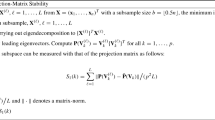Abstract
Neural independent component learning algorithms based on optimization on manifolds have attracted interest in the neural network community. In the past years, we have developed learning algorithms specialized for the orthogonal group of matrices as parameters manifold. Here, we sketch a view of these algorithms by the help of ‘retractions’ on manifolds.
Similar content being viewed by others
References
Fiori S (2005). Quasi-geodesic neural learning algorithms over the orthogonal group: a tutorial. J Machine Learn Res 6: 743–781
Nishimori Y, Akaho S (2005) Learning algorithms utilizing quasi-geodesic flows on the Stiefel manifold. Neurocomputing (Special issue on “Geometrical methods in Neural Networks and Learning”. In: Amari S-I, Fiori S) (eds) (Vol. 67, pp 106–135), August 2005
Plumbley MD (2005) Geometrical methods for non-negative ICA: Manifolds, Lie groups and toral subalgebras. Neurocomputing (Special issue on “Geometrical methods in Neural Networks and Learning”. In: Amari S-I, Fiori S) (eds) (Vol. 67, pp 161–197), August 2005
Amari S-i and Fiori S (2005). Editorial: Special issue on “Geometrical Methods in Neural Networks and Learning”. Neurocomputing 67: 1–7
Fiori S (2004). A fast fixed-point neural blind deconvolution algorithm. IEEE T Neural Networks 15(2): 455–459
Yamada I and Ogura N (2004). Adaptive projected subgradient method for asymptotic minimization of sequence of nonnegative convex functions. Numer Funct Anal Opt 25(7 & 8): 593–617
Fiori S (2002). A theory for learning based on rigid bodies dynamics. IEEE T Neural Networks 13(3): 521–531
Tanaka T, Fiori S (2006) Simultaneous tracking of the best basis in reduced-rank Wiener filter. International Conference on Acoustics, Speech and Signal Processing Vol. III, IEEE-ICASSP, Toulouse, France, May 2006, pp 548–551
Fiori S (2006). Fixed-point neural independent component analysis algorithms on the orthogonal group. Future Gener Comput Syst 22(4): 430–440
Hyvärinen A, Karhunen J and Oja E (2001). Independent component analysis. John Wiley & Sons, New York
Regalia PA and Kofidis E (2003). Monotonic convergence of fixed-point algorithms for ICA. IEEE T Neural Networks 14(4): 943–949
Liu X, Srivastava A and Gallivan K (2004). Optimal linear representation of images for object recognition. IEEE T Pattern Anal Machine Intell 26(5): 662–666
Plumbley MD (2003). Algorithms for nonnegative independent component analysis. IEEE T Neural Networks 14(3): 534–543
Celledoni E and Fiori S (2004). Neural learning by geometric integration of reduced ‘rigid-body’ equations. J Comput Appl Math 172(2): 247–269
Taylor CJ, Kriegman DJ (1994) Minimization on the Lie group SO(3) and related manifolds. Technical Report No. 9405 of the Yale University, April 1994
Absil P-A, Baker CG, Gallivan KA (2004) Trust-region methods on Riemannian manifolds. Technical Report FSU-CSIT-04-13 of the School of Computational Science at Florida State University, July 2004
Celledoni E and Owren B (2002). A class of intrinsic schemes for orthogonal integration. SIAM J Numer Anal 40(6): 2069–2084
Fiori S (2005) Fixed-point learning algorithms over the unitary group of matrices. Technical report, Dipartimento di Elettronica, Intelligenza Artificiale e Telecomunicazioni, Università Politecnica delle Marche, August 2005
Akuzawa T (2000) Extended quasi-Newton method for the ICA. In: Proceedings of 2nd International Symposium on Independent Component Analysis and Blind Signal Separation (ICA’2000), Helsinki (Finland), June 2000, pp 521–525.
Cichocki A and Amari S-i (2002). Adaptive blind signal and image processing. J. Wiley & Sons, New York
Yamada I, Ezaki T (2003) An orthogonal matrix optimization by dual Cayley parameterization technique. Proceedings of 4th International Symposium on Independent Component Analysis and Blind Signal Separation (ICA’2003), Nara (Japan), April 2003, pp 35–40
Choi S, Cichocki A, Park H-M and Lee S-Y (2005). Blind source separation and independent component analysis: a review. Neural Inform Process – Lett Rev 6(1): 1–57
Author information
Authors and Affiliations
Corresponding author
Rights and permissions
About this article
Cite this article
Fiori, S. Learning independent components on the orthogonal group of matrices by retractions. Neural Process Lett 25, 187–198 (2007). https://doi.org/10.1007/s11063-007-9037-x
Received:
Accepted:
Published:
Issue Date:
DOI: https://doi.org/10.1007/s11063-007-9037-x




